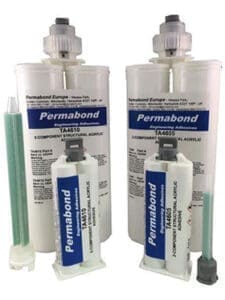Bonding EPDM? Chances are you have stumbled across this article as you are having trouble bonding EPDM rubber… It is notoriously difficult to bond. Even its name sends shivers down the spines of industry professionals! For surface preparation, solvent wipe with Isopropanol and allow to evaporate. This removes surface contamination, dust or any release agent that may hinder bonding.

Permabond TA4605 and Permabond TA4610 structural acrylic adhesives bond untreated EPDM, and recent lab tests show a 3-5 N/mm² shear strength leading to 300% elongation of the EPDM before resulting in substrate failure. This opens up many opportunities for EPDM bonding applications that require gap fill and water resistance. TA4610 has a delayed set time to allow spreading over a large area and with time for adjustments. Generally, other adhesives have trouble bonding to EPDM due to the high content of polyolefin compounds in the EPDM.
Cyanoacrylate adhesive is one choice if you are looking for a high strength bond. Permabond recommends its 105 grade cyanoacrylate for this troublesome substrate. Generally bond strength of this industrial adhesive exceeds that of the substrate material (in destructive tests, the EPDM rubber will tear). Using a cyanoacrylate adhesive can be restrictive – gap fill is <0.5mm and the adhesive doesn’t lend itself to spreading with a roller or scraper. Cyanoacrylates cure in seconds. You may not have time to readjust after assembly.
If I use a cyanoacrylate, won’t durability be an issue in water?
Cyanoacrylates tend to degrade quite quickly in water, particularly if it is hot. However, if your joint is well designed and there is a reasonably sized bond area with minimal interface in contact with the water, chances are you will be OK. Accelerated ageing tests in a high temperature humidity cabinet will help you confirm as to whether the adhesive will withstand long-term exposure.
EPDM (ethylene propylene diene monomer) rubber is a type of synthetic rubber elastomer. It has excellent heat and chemical resistance and because of that its use is widespread – particularly in the automotive industry. It is normally black, non-tacky and often has a slightly dusty feel about it.
Automotive door seals and hoses are manufactured from EPDM rubber. Other applications include roofing membranes, safety floor tiles around pools and playgrounds, o-rings, washers, belts, speaker cone surrounds, gaskets, washing machine door seals, cable connectors, cable insulation; the list goes on…
For further help and information on bonding EPDM rubber, please contact the Permabond technical team here.